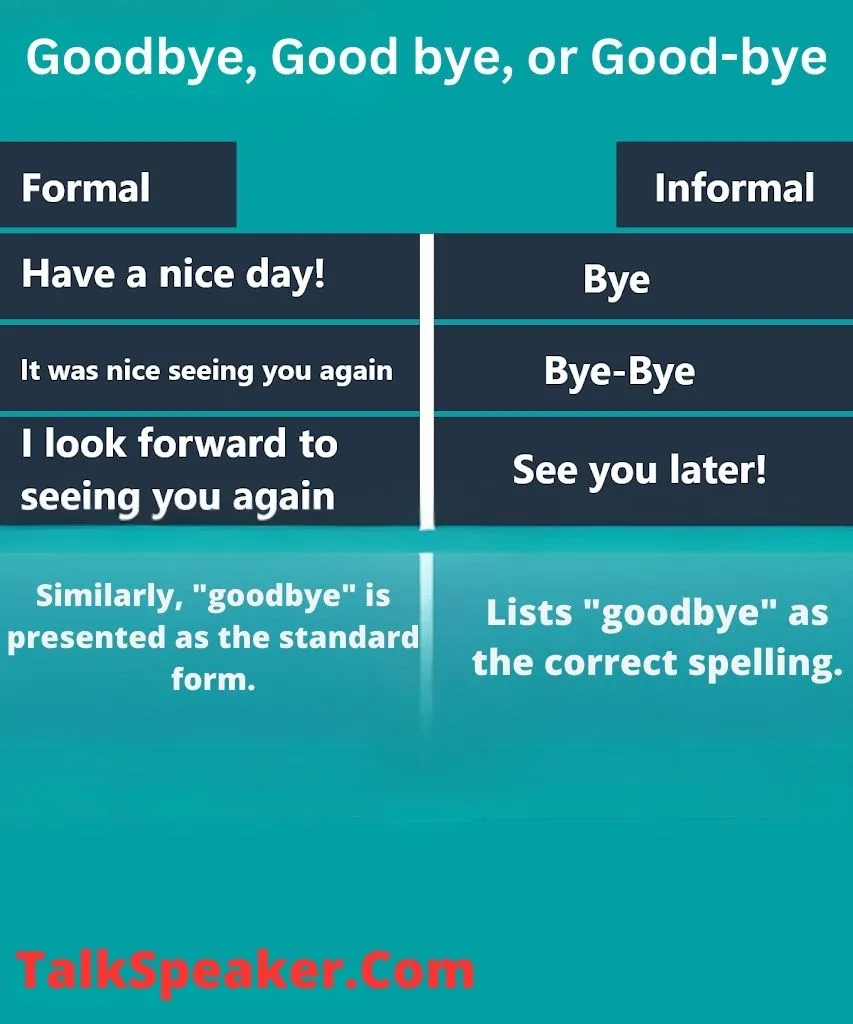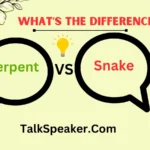Last updated on October 22nd, 2024 at 04:09 pm
Confused about whether it’s ‘Goodbye,‘ ‘Good bye,‘ or ‘Good-bye‘?
Discover the fascinating history behind this simple word and learn how to use it correctly in all contexts.
The simple word “goodbye” can cause a surprising amount of confusion. Is it “Goodbye,” “Good bye,” or “Good-bye“? This seemingly trivial question has sparked debate among writers, linguists, and English learners.
This comprehensive guide delves into the history, usage, and nuances of the term “goodbye,” exploring why it matters and how to use it correctly.
The Evolution of the Term ‘Goodbye’
The term “goodbye” has a fascinating history. It evolved from a phrase used in early English to its modern form.
Originally, “goodbye” was a contraction of “God be with ye,” a common farewell in the 16th and 17th centuries.
Historical Background
The phrase “God be with ye” was a standard way of bidding farewell in Elizabethan England. People would use it to wish others well as they parted ways.
Over time, this phrase underwent phonetic simplification. The contraction “goodbye” emerged as a more casual and succinct way to say farewell.
Changes Over Time
As English evolved, so did the spelling and pronunciation of “goodbye.” During the 18th and 19th centuries, variations like “Good bye” and “Good-bye” appeared alongside the more modern “goodbye.”
These changes reflect shifts in spelling conventions and linguistic trends.
Influences on Evolution

Several factors influenced the evolution of “goodbye.” The rise of standardized spelling, driven by dictionaries and printing, played a significant role.
Additionally, social changes and regional dialects contributed to the variations in how people used the term.
Goodbye, Good bye, or Good-bye: Which Is Correct?
When deciding between “Goodbye,” “Good bye,” and “Good-bye,” it’s important to consider current conventions and usage.
Standard Usage
In contemporary English, “goodbye” is the most widely accepted form. Major dictionaries and style guides recommend using “goodbye” in both formal and informal contexts.
It’s the standard spelling that most people recognize and use.
Contextual Usage
While “goodbye” is the preferred form, “Good-bye” and “Good bye” are still seen occasionally. “Good-bye” may appear in more formal or traditional texts, while “Good bye” might be used in specific stylistic contexts.
However, these variations are less common and might be viewed as outdated or incorrect by some readers.
Expert Opinions
Linguists and grammarians generally agree that “goodbye” is the correct and most appropriate spelling for modern usage.
According to the Oxford English Dictionary, “goodbye” is the standard spelling used in current English.
The Role of Dictionaries and Style Guides
Dictionaries and style guides provide authoritative guidance on spelling and usage, including the term “goodbye.”
Dictionary Entries
- Merriam-Webster: Lists “goodbye” as the correct spelling.
- Oxford English Dictionary: Similarly, “goodbye” is presented as the standard form.
- Cambridge Dictionary: Also confirms “goodbye” as the preferred spelling.
These entries reflect the consensus in the English language community.
Style Guides
- The Chicago Manual of Style: Recommends “goodbye” for formal writing.
- The Associated Press (AP) Stylebook: Also supports “goodbye” as the correct form.
- The MLA Handbook: Consistently uses “goodbye” in academic and professional writing.
Comparisons
Dictionaries and style guides are aligned in their recommendation for “goodbye.”
This consistency helps establish “goodbye” as the standard spelling and usage in modern English.
Regional Variations in Using Goodbye
The usage of “goodbye” can vary depending on geographic location and cultural context.
Geographic Differences
- United States: “Goodbye” is universally accepted and used.
- United Kingdom: Similar to the US, “goodbye” is the standard form.
- Canada and Australia: Both follow the British convention, using “goodbye.”
Examples from Different Regions
- US: Commonly seen in both casual and formal contexts.
- UK: Sometimes “good-bye” appears in more formal or historical texts.
- Canada and Australia: Primarily use “goodbye,” with occasional regional variations.
Reasons for Regional Variations
These variations arise from historical influences, regional dialects, and cultural practices. However, “goodbye” remains the dominant form in all these regions.
Struggling with English? Elevate your skills with our expert guides and tips—unlock your potential At Talk Speaker!
Common Misconceptions About Saying Farewell
Misconceptions about “goodbye” can lead to confusion and incorrect usage.
Misconception 1: “Goodbye” Is Old-Fashioned
Some people view “goodbye” as outdated. However, it remains widely used and accepted in contemporary English.
It’s a standard farewell that fits various contexts, from casual to formal.
Misconception 2: “Good bye” Is Incorrect
“Good bye” is not incorrect but is less common and considered less standard compared to “goodbye.”
It may be used for stylistic reasons but is generally not preferred in formal writing.
Clarifications
“Goodbye” is the preferred form in modern English. The other variations may be used in specific contexts but are less common.
Examples of Saying Goodbye in Different Contexts
Understanding how “goodbye” is used in various contexts can help you choose the right form for your situation.
Formal vs. Informal
- Formal: Use “goodbye” in formal letters, speeches, and professional settings.
- Informal: “Goodbye” is also appropriate for casual conversations and social settings.
Written vs. Spoken
- Written Communication: “Goodbye” is the standard form used in letters, emails, and official documents.
- Spoken Communication: In everyday speech, “goodbye” is the most common form, though variations might occur in informal settings.
Cultural Examples
- In English Literature: Classic texts often use “good-bye” or “goodbye,” reflecting historical spelling conventions.
- In Modern Media: Films and books predominantly use “goodbye,” aligning with current standards.
The Contraction ‘Goodbye’ and Its Historical Roots
The contraction “goodbye” has intriguing historical roots that trace back to earlier forms of English.
Contraction Explained
“Goodbye” is a contraction of “God be with ye.” This contraction simplified the original phrase, making it more convenient for everyday use.
Historical Roots
- Early Usage: The phrase “God be with ye” was a common farewell in medieval England.
- Evolution: Over time, “goodbye” emerged as a more informal and shortened version of the original phrase.
Evolution of the Contraction
The transition from “God be with ye” to “goodbye” reflects broader changes in English spelling and pronunciation.
This evolution showcases how language adapts to the needs of its speakers.
Tracing the Etymology: From ‘God Be With Ye’ to Today
The etymology of “goodbye” provides insight into its development and current usage.
Etymology Breakdown
- Original Phrase: “God be with ye” was a blessing and farewell.
- Phonetic Changes: Over time, the phrase was shortened to “goodbye,” reflecting changes in spoken English.
Historical Usage
Historical texts reveal how “God be with ye” was used in various contexts, from literature to everyday speech.
Transformation
The transformation from “God be with ye” to “goodbye” illustrates the dynamic nature of language and its evolution over centuries.
Impact of ‘Goodbye’ on Language and Culture
The term “goodbye” has had a significant impact on language and culture.
Linguistic Impact
“Goodbye” has influenced other farewell expressions and idioms.
Its widespread use has helped shape how people say farewell in different contexts.
Cultural Significance
- In English-Speaking Cultures: “Goodbye” is a standard farewell, reflecting its cultural importance.
- In Global Contexts: The term has been adopted in various languages and cultures, demonstrating its universal appeal.
Media and Literature
“Goodbye” appears frequently in literature, films, and popular culture, highlighting its significance and continued relevance.
Creative Ways to Say Goodbye in Writing and Speech
Exploring creative ways to say goodbye can enhance your communication and add a personal touch.
Synonyms
- Farewell
- Adieu
- See you later
- Take care
- Until next time
Creative Farewells
- In Letters: Use phrases like “Wishing you all the best” or “Until we meet again.”
- In Speech: Try “Catch you later” or “Have a great one.”
Practical Tips
- Consider Context: Choose a farewell that fits the formality of the situation.
- Personalize: Add a personal touch to make your goodbye more memorable.
Conclusion
Understanding the correct usage of “goodbye” enhances your communication and helps you navigate various contexts effectively. While “goodbye” is the standard form, variations like “Good-bye” and “Good bye” may still appear in specific settings.
By knowing the history, usage, and regional differences, you can confidently use “goodbye” in your writing and speech.
Whether you’re bidding farewell in a formal letter or a casual conversation, choosing the right form ensures that your message is clear and appropriate. Embrace the richness of the English language and use “goodbye” thoughtfully in your communications.
The simple word “goodbye” can cause a surprising amount of confusion. Is it “Goodbye,” “Good bye,” or “Good-bye“? This seemingly trivial question has sparked debate among writers, linguists, and English learners.
Understanding the correct usage of “goodbye” not only clarifies your writing but also helps you navigate various social and formal contexts.
This comprehensive guide delves into the history, usage, and nuances of the term “goodbye,” exploring why it matters and how to use it correctly.

As an experienced English teacher, I’m Jessica Thompson, here to make grammar and vocabulary simple and fun. Join me on TalkSpeaker as we explore the language together, one lesson at a time!



